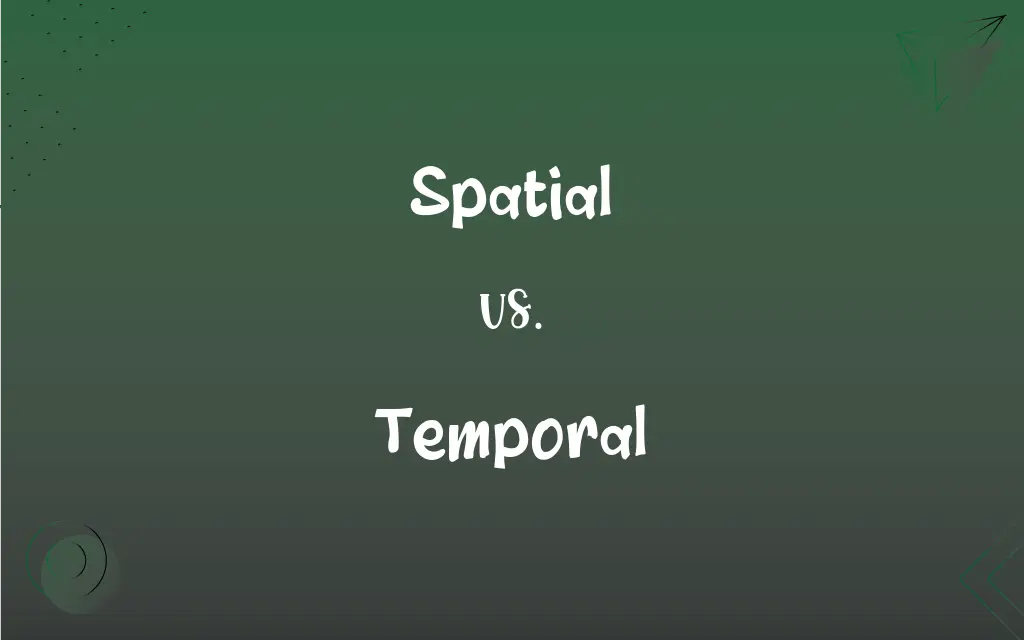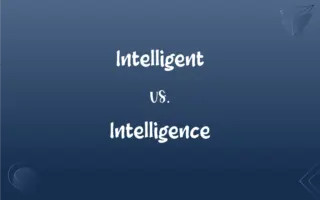Spatial vs. Temporal: What's the Difference?
By Janet White || Updated on March 4, 2024
Spatial relates to space and the physical arrangement of objects within it, while temporal pertains to time and the sequencing of events over it.

Key Differences
Spatial aspects focus on where things are located, their arrangement, and the relationships between objects in space. This includes understanding dimensions, distances, directions, and the structure of environments. Spatial thinking is crucial in fields like geography, architecture, and urban planning, where the physical layout and spatial relationships are key. Temporal aspects, on the other hand, concern the dimension of time. This involves the duration of events, their sequencing, and the intervals between them.
While spatial information helps us navigate the world and organize our physical environment, temporal information allows us to schedule our lives, understand historical contexts, and plan for the future. The two are often interconnected; for example, understanding the spatial layout of an ancient city can provide insights into its historical development, linking spatial and temporal analysis.
Spatial intelligence involves the ability to visualize with the mind's eye, crucial for solving problems related to physical spaces, such as navigation, engineering, and visual arts. Temporal intelligence, however, involves the understanding and reasoning of timing and sequencing, which is vital in music, storytelling, and strategic planning.
The technologies and methodologies used to analyze spatial and temporal aspects also differ. Geographic Information Systems (GIS) are used for mapping and analyzing spatial data, while temporal analysis might involve timelines, Gantt charts in project management, or statistical methods to examine changes over time.
Despite their differences, both spatial and temporal analyses are crucial for comprehensive understanding in many fields, combining to provide a fuller picture of how events and objects relate within the dimensions of space and time.
ADVERTISEMENT
Comparison Chart
Definition
Pertaining to space and the arrangement of objects within it.
Pertaining to time and the sequencing of events over it.
Key Focus
Location, distance, layout, and spatial relationships.
Duration, sequencing, intervals, and historical timing.
Importance In
Geography, architecture, urban planning.
History, project management, scheduling.
Intelligence Type
Spatial intelligence: visualizing physical spaces.
Temporal intelligence: understanding and reasoning about time.
Analytical Tools
Geographic Information Systems (GIS), spatial mapping.
Timelines, Gantt charts, statistical methods.
ADVERTISEMENT
Interconnection
Spatial analysis can inform historical and future developments.
Temporal analysis can influence spatial planning and usage.
Spatial and Temporal Definitions
Spatial
Relating to the arrangement and organization of physical spaces.
Architects consider the spatial layout to design functional buildings.
Temporal
Concerning the sequence and duration of events.
Temporal analysis is used to study historical events chronologically.
Spatial
Involving the position and distance between objects.
Spatial awareness is crucial for navigating through crowded cities.
Temporal
Relates to timing and the passage of time.
Temporal precision is essential in musical performances.
Spatial
Used in mapping and analyzing geographical data.
GIS technology enables the spatial analysis of environmental patterns.
Temporal
Pertains to the timing and rate of changes over time.
Temporal trends in climate data reveal global warming patterns.
Spatial
Pertains to the visual and physical aspects of space.
Spatial art focuses on the interaction between materials and physical space.
Temporal
Used in understanding historical contexts and futures.
Temporal studies in literature explore the evolution of narrative forms over time.
Spatial
Concerns the geometry and physical positions in space.
Spatial mathematics is applied in constructing accurate models of buildings.
Temporal
Involves the scheduling and planning of future actions.
Project managers use temporal planning to meet deadlines.
Spatial
Of, relating to, involving, or having the nature of space.
Temporal
Of, relating to, or limited by time
A temporal dimension.
Temporal and spatial boundaries.
Spatial
Pertaining to (the dimension of) space.
Temporal
Of or relating to the material world; worldly
The temporal possessions of the Church.
Spatial
(uncommon) Pertaining to (outer) space.
Temporal
Lasting only for a time; not eternal; passing
Our temporal existence.
Spatial
Of or pertaining to space.
Temporal
Secular or lay; civil
Lords temporal and spiritual.
Spatial
Pertaining to or involving or having the nature of space;
The first dimension to concentrate on is the spatial one
Spatial ability
Spatial awareness
The spatial distribution of the population
Temporal
(Grammar) Expressing time
A temporal adverb.
Temporal
Of, relating to, or near the temples of the skull.
Temporal
(relational) Of or relating to the material world, as opposed to sacred or clerical.
Temporal power, temporal courts
Temporal
(relational) Relating to time:
Temporal
Of limited time, transient, passing, not perpetual, as opposed to eternal.
Temporal
Of or relating to time as distinguished from space.
Temporal
Of or relating to the sequence of time or to a particular time.
Temporal
(grammar) Relating to or denoting time or tense.
Temporal
Of or situated in the temples of the head or the sides of the skull behind the orbits.
Temporal
Anything temporal or secular; a temporality.
Temporal
(skeleton) temporal bone
Temporal
(zootomy) Any of a reptile's scales on the side of the head between the parietal and supralabial scales, and behind the postocular scales.
Temporal
Of or pertaining to the temple or temples; as, the temporal bone; a temporal artery.
Temporal
Of or pertaining to time, that is, to the present life, or this world; secular, as distinguished from sacred or eternal.
The things which are seen are temporal, but the things which are not seen are eternal.
Is this an hour for temporal affairs?
Temporal
Civil or political, as distinguished from ecclesiastical; as, temporal power; temporal courts.
Temporal
Anything temporal or secular; a temporality; - used chiefly in the plural.
He assigns supremacy to the pope in spirituals, and to the emperor or temporals.
Temporal
The semantic role of the noun phrase that designating the time of the state or action denoted by the verb
Temporal
Not eternal;
Temporal matters of but fleeting moment
Temporal
Of or relating to or limited by time;
Temporal processing
Temporal dimensions
Temporal and spacial boundaries
Music is a temporal art
Temporal
Of or relating to the temples (the sides of the skull behind the orbit);
Temporal bone
Temporal
Of the material world;
Temporal possessions of the church
Temporal
Concerned with secular rather than sacred matters;
Lords temporal and spiritual
Temporal
Of this earth or world;
Temporal joys
Our temporal existence
FAQs
Why is spatial awareness important?
Spatial awareness is crucial for navigation, understanding our environment, planning physical spaces, and in many visual and practical tasks.
What does temporal mean?
Temporal pertains to time, including the duration, sequencing, and timing of events and phenomena.
How do spatial and temporal analyses differ?
Spatial analysis focuses on physical space and its organization, while temporal analysis deals with the dimension of time and event sequencing.
Can spatial and temporal elements be interconnected?
Yes, spatial and temporal analyses often intersect, as understanding the spatial arrangement can provide insights into temporal changes and vice versa.
What does spatial mean?
Spatial refers to anything related to space, including the arrangement, organization, and relationships of objects within physical spaces.
What tools are used for spatial analysis?
Tools like Geographic Information Systems (GIS), spatial mapping, and 3D modeling are used for spatial analysis.
How do architects use spatial concepts?
Architects use spatial concepts to design buildings and spaces that are functional, aesthetically pleasing, and efficient in their use of space.
What role does spatial intelligence play in daily life?
Spatial intelligence aids in everyday tasks such as reading maps, packing, organizing spaces, and navigating, enhancing our interaction with the physical world.
Can temporal concepts apply to digital technology?
Yes, temporal concepts are crucial in digital technology for data organization, software development, multimedia, and in managing the timing of processes and operations.
What is the significance of temporal data in scientific research?
Temporal data is significant in scientific research for tracking changes over time, analyzing trends, and making predictions in fields like climatology, epidemiology, and social sciences.
How is temporal intelligence applied in real life?
Temporal intelligence is applied in scheduling, planning, understanding historical contexts, music, and any activity requiring an understanding of timing and sequence.
How can spatial and temporal analyses improve public health?
Spatial and temporal analyses can improve public health by tracking disease spread, planning healthcare services, analyzing environmental health risks, and scheduling public health interventions.
What methodologies are used in temporal analysis?
Temporal analysis utilizes timelines, Gantt charts for project scheduling, and statistical methods to study changes over time.
How do urban planners utilize spatial analysis?
Urban planners use spatial analysis to design city layouts, optimize land use, plan transportation networks, and ensure sustainable development within physical spaces.
What examples illustrate the use of temporal analysis in business?
In business, temporal analysis is used for market trend analysis, financial forecasting, project scheduling, and optimizing production timelines to improve efficiency and profitability.
Why are spatial-temporal skills important in education?
Spatial-temporal skills are important in education for developing problem-solving abilities, understanding mathematical concepts, and enhancing comprehension in subjects like science and geography.
How does spatial analysis contribute to environmental conservation?
Spatial analysis helps in environmental conservation by mapping ecosystems, assessing land use changes, planning conservation areas, and monitoring habitat destruction.
How do video games incorporate spatial and temporal elements?
Video games incorporate spatial elements in level design, navigation, and interaction with objects, while temporal elements are used in timing challenges, narrative progression, and event sequencing.
Why is temporal analysis important in history?
Temporal analysis helps historians understand the sequence of events, their duration, and their impact over time, providing a chronological perspective on historical developments.
What challenges exist in integrating spatial and temporal data?
Challenges in integrating spatial and temporal data include managing large datasets, ensuring data accuracy, synchronizing data from different sources, and developing models that accurately represent both spatial and temporal dynamics.
About Author
Written by
Janet WhiteJanet White has been an esteemed writer and blogger for Difference Wiki. Holding a Master's degree in Science and Medical Journalism from the prestigious Boston University, she has consistently demonstrated her expertise and passion for her field. When she's not immersed in her work, Janet relishes her time exercising, delving into a good book, and cherishing moments with friends and family.
































































